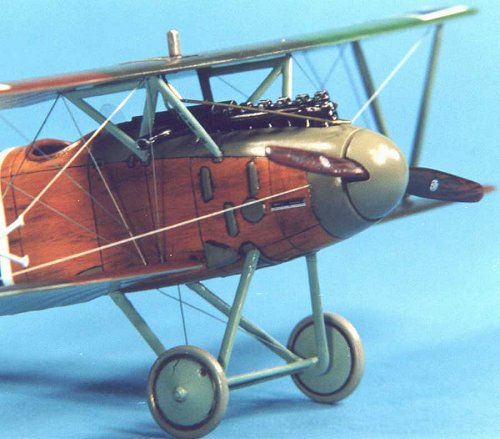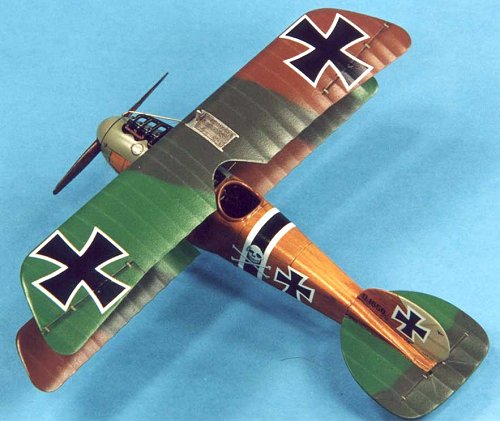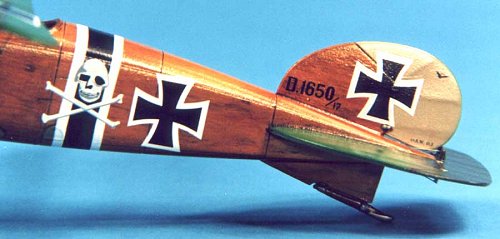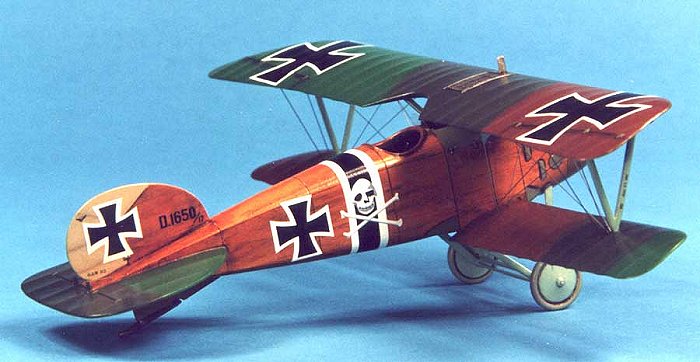
|
KIT: |
Eduard 1/48 Albatros D.III OAW |
|
KIT # |
8038 |
|
PRICE: |
$22.50 |
|
DECALS: |
Two Aircraft |
|
REVIEW & |
|
|
NOTES: |

|
HISTORY |
The design of the Albatros D.III was heavily influenced by the highly successful Nieuport series of sesquiplane fighters, which featured superior maneuverability over its German rivals. This design featured a significantly narrower lower wing and improved the maneuverability and rate of climb significantly over the Albatros D.II. In fact, the D.III was merely a D.II fuselage with new wings. Unfortunately, the sesquiplane design had an inherent flaw, which was exacerbated by the somewhat heavier in-line engine, in that its lower wing was prone to failure during long dives or hard maneuvering. The famous Manfred von Richtofen originally stopped flying the D.III for about a month instead favoring the less capable Halberstadt D.II fighter. However, the superiority of the D.III to its Allied air opposition quickly overcame this weakness and the D.III went on to a very successful war record, dominating the skies during "Bloody April" 1917.
The Albatros D.III was produced by several manufacturers including 840 completed by the Ostdeutsche Albatros Werke (OAW) at the East German factory at Schneidemuhl. The OAW built variant was virtually identical to those built at the Albatros factory at Johannistahl, with the only significant difference being the shape of the rudder.
|
THE KIT |
The kit is Eduardís Albatros D.III OAW (8038), which consists entirely of injected molded plastic and lacks the resin and photo-etch pieces found in the Profipack version. The injected molded plastic pieces are identical to several other Albatros D.III kits marketed by Eduard, the only difference being the addition of the rounded OAW rudder. The plastic parts are high quality injected molded pieces that rivals Tamiya/Hasegawa in quality. The instruction sheet is the usual eight page diagram assembly with marked color painting guidelines, and a cross reference to Tamiya, Humbrol, Revell, Testor, and Aeromaster paints.
|
CONSTRUCTION |
 I started by
pre-painting all the parts as indicated in the instructions, with the exception
of the fuselage walls, bulkheads, floors, and engine mount floor which I covered
with Tauro wood grain decal. The stringer detail on the fuselage sidewalls were
then hand painted Testor Model Master (TMM) French Chestnut and given a light
wash of burnt umber.
I started by
pre-painting all the parts as indicated in the instructions, with the exception
of the fuselage walls, bulkheads, floors, and engine mount floor which I covered
with Tauro wood grain decal. The stringer detail on the fuselage sidewalls were
then hand painted Testor Model Master (TMM) French Chestnut and given a light
wash of burnt umber.
Assembly of the fuselage components was accomplished using super-thin superglue. Assembly proceeded as described in the instructions, with no major problems. I then skipped over the instruction sequence for the machine guns and started on the engine.
The engine components were next as I painted them, assembled them together, and then gave the whole assembly a heavy wash of black. I installed the engine floorboard to the fuselage side, wrapped the top half of the engine (exhaust stack was not installed yet) in parafilm, and installed the engine into the fuselage with superglue.
I then closed up the fuselage with liquid cement. Next, I glued with liquid cement the tail fin, the skid fairing, and lower wing to the fuselage. All joins were then sanded smooth, and no putty was required for gap filling. Then I drilled all of the rigging, strut, and landing gear mounting holes as described in the instructions. Next stop was the paint shop.
 The model was painted,
decaled, and weathered as described in the following subsections and then final
assembly took place.
The model was painted,
decaled, and weathered as described in the following subsections and then final
assembly took place.
I installed the interplane and cabane struts into place and drilled small holes in the radiator to fit short sections of corresponding diameter brass wire for the radiator to engine piping. Superglue the wire to the radiator in the drilled holes and you will get a very sturdy join.
Now onto the fun part, putting on the top wing! Actually, this task went smoothly with no problems. Since the cabane struts are already fixed in the correct position on the fuselage (using a caliper to set the actual distance) the top wing snapped into place in the correct position. I used small rubber bands to help hold both wings in place and then checked alignment of the top to bottom wing. When all was to my liking, I superglued the struts to the wing.
Now on to the next challenge, installing the landing gear! I installed metal pins into the ends to help ease this task. Push the pinned legs of the landing gear into the fuselage and set the approximate width of the landing gear axle. Then place the axle into place on the legs and after carefully aligning everything glue it in place. Let the glue fully cure then paint the assembly and let dry. Glue one leg into place with superglue, let set, then glue the remaining legs into place. Lastly install the painted wheels into place on the axle with superglue, and the tailskid.
Carefully install the exhaust stack, propeller, and propeller spinner with superglue. I drilled out the exhaust stacks, painted them Testor Metalizer Burnt Iron and then applied a heavy wash of Rustall. The propeller was painted by using a base coat of dark yellow, and successive light dry brushing using a rake brush of TMM raw sienna, raw umber, burnt sienna, and burnt umber to replicate the wood grain.
Install all the remaining pieces as indicated in the instructions and rig the model as indicated on the instruction sheet.
|
PAINT & MARKINGS |
 As mentioned above, all
painting was done after completion of the fuselage and attachment of the lower
wing fairly early in the construction process. I started first by airbrushing
the entire fuselage and tail section Gunze Sangyo Sail Color (H-85). This color
also served as the base color for my wood grain finish discussed later. The cowl
portions and spinner were then masked and sprayed with Aeromaster RLM 02 Grau
(9020). I then shot the underside of the wings with Xtracolor German WWI
Underside Blue (X243). The top wings were sprayed freehand with Aeromaster RLM
83 Lichtgrun (9031), Aeromaster A/N Brown Primer (9096), and Xtracolor German
WWI Topside Green (X241).
As mentioned above, all
painting was done after completion of the fuselage and attachment of the lower
wing fairly early in the construction process. I started first by airbrushing
the entire fuselage and tail section Gunze Sangyo Sail Color (H-85). This color
also served as the base color for my wood grain finish discussed later. The cowl
portions and spinner were then masked and sprayed with Aeromaster RLM 02 Grau
(9020). I then shot the underside of the wings with Xtracolor German WWI
Underside Blue (X243). The top wings were sprayed freehand with Aeromaster RLM
83 Lichtgrun (9031), Aeromaster A/N Brown Primer (9096), and Xtracolor German
WWI Topside Green (X241).
Next I replicated the wood grain finish on the fuselage. Previously, I had good success using a dry brushing technique with a rake brush that I used for smaller pieces. Starting with the sail color finish, I lightly dry brushed successive colors of TMM Raw Umber, Raw Sienna, Burnt Sienna, and Burnt Umber atop each other in a random pattern. I then dry brushed with a rake brush Humbrol Oak (#71) to randomly cover and let peek through the underlying dry brushed colors in an approximate wood grain pattern. After letting this cure overnight I shot many coats of Gunze Sangyo (GS) Clear Yellow (H91) tinted with 10 drops of GS Clear Orange (H92) to get that Albatros wood grain yellow look. In retrospect, the 10 drops of orange was a bit too much, 5 drops would have been more appropriate (but your tastes may vary!). A word of caution, you must apply many, many, many coats of clear yellow (I probably did about 10-12) to get that nice rich honey amber hue. After a day of drying time, I sprayed a light coat of Future in preparation for decaling.
The decals supplied with the kit are typical Eduard decals. Super thin and
super fragile. After a short drying period of about an hour, I applied MicroSol
setting solution to get the decals to melt into the surface and the control
surfaces. I repeated with a second coat of setting solution to get all the
decals fully down. After drying overnight, I wiped the decals off with a moist
cloth with a bit of soap to remove any residue and after drying I shot a very
light coat of Future over the decals
 to seal them. For weathering, I chose to accentuate the engraved
panel lines and surface detail with a light burnt umber oil wash.
to seal them. For weathering, I chose to accentuate the engraved
panel lines and surface detail with a light burnt umber oil wash.
I then sealed everything with a light coat of PS Flat Finish to provide a surface for pastel application. I then used a pastel pencil to lightly highlight the rib detail on the wings/tail surfaces and to apply a brown tint (in varying densities) to represent the wood panels. I then randomly applied some ground up burnt umber pastels with a soft brush to simulate dirt staining on the lower surfaces. Lastly, I applied a heavy burnt umber oil wash to the wheels and control surface joins.
I then finished final assembly of the models as described above. Finally, several coats of Polly Scale Satin Finish were shot to achieve the final semi-gloss finish common to most WWI aircraft.
|
CONCLUSIONS |
This is an excellent model of an important WW I aircraft. Overall the quality and accuracy are exceptional. The level of detail engraved in the kit is a great improvement over previous generation Eduard models, and no after-market sets are really needed for a beautiful build. I highly recommend this kit for all levels of builders including beginners. For those modelers that have built Eduard kits in the past and swore them off due to the poor fit and construction problems, this model will definitely change your opinion. This would be an excellent kit for beginners or first time WW I modelers.

|
REFERENCES |
Squadron/Signal Publications, Albatros Fighters In Action, SS1046, $8.95
Grub Street, Under The Guns Of The German Aces, $35.00
Albatros Productions LTD, Windsock Datafile, Albatros Fighters, $25.00
If you would like your product reviewed fairly and quickly by a site that has over 1,700 visits a day, please contact me or see other details in the Note to Contributors.